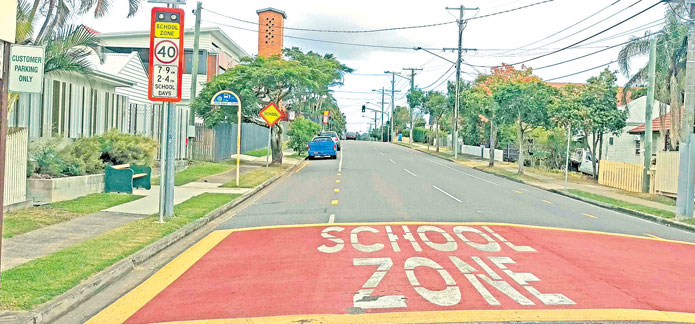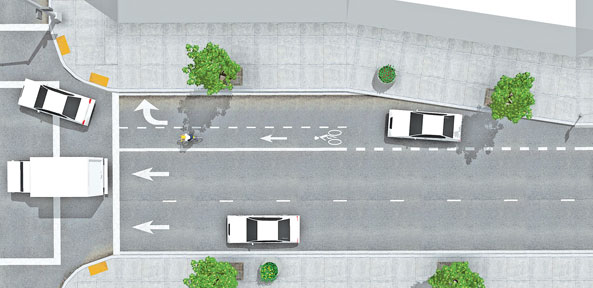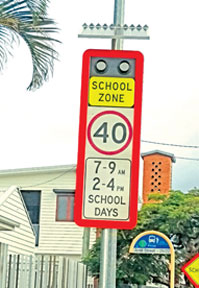Transportation in Brisbane and Sri Lanka, a comparison
Use of horns very rare:
Limited city parking:
By Dushan Tissera
 From a country that always portrays a zest for life and values the
unity of family to a country with a western culture that lives off the
edge must normally be a shock to any person. This won't be so. Why? The
world is flat as stated by Thomas L. Friedman. From a country that always portrays a zest for life and values the
unity of family to a country with a western culture that lives off the
edge must normally be a shock to any person. This won't be so. Why? The
world is flat as stated by Thomas L. Friedman.
However, the perception of difference was evident. This was not in
the form of the amount of coffee consumption, Friday night parties and
focus on food, but in the level of thinking and planning that has been
embodied in the transportation network.
Brisbane city and its suburbs has some of the best planned roads in
the world. The surprise is that these roads and the rules that govern
the movement of vehicles have a lot in common to what is seen in Sri
Lanka.
The vehicles are left-side driven with the driver on the right. Road
signage is peculiarly common to that of Sri Lanka. However, the system
as a whole is superior compared to Sri Lanka. Congested traffic is
barely a normality in the rush hour. Australia has a landmass of
7,682,300 square kilometres (Source: Passport GMID) and a population of
23.6 million in 2014 and an estimated 23.9 million in 2015 (EIU Country
Data).
Hence, the land to people ratio is such that roads are not highly
congested (even when a large amount of land is uninhabited). However,
traffic congestion can be seen during peak hours within the city and
bordering the suburbs occasionally.
Whether it is in the suburbs or the city, traffic lights and advising
road signage is a common sight. For any driver, the influx of
information can be overwhelming. All the information one needs to drive
safely is provided at every point throughout the journey. Attention to
detail is commendable.
Cameras
There are speed cameras and red light cameras at strategically
selected points to keep driver discipline in-check. However, there are
traffic cameras in most areas for surveillance. Driver discipline is
highlighted by the rows of vehicles flowing through the roads.
All vehicles respect the individual lanes with caution and instructed
signalling at all turns and lane changes. The use of horns is rare and
only heard in times of imminent danger. Pedestrians and cyclist are
always given priority and that is done more as an act of courtesy as
opposed to a part of law.
It is mandatory that a vehicle comes to a complete standstill at all
'Stop' signs.
You will be penalized if you fail to do so. Traffic fines are high.
For example, the fine for not wearing the seat belt is AUD 353 which is
about Rs. 40,000 (rate may differ due to currency fluctuations with
time).
 This can be cited as a huge incentive to follow traffic rules.
Further, at all giveaway points (which are always designated with
signage), the rule is followed meticulously. This can be cited as a huge incentive to follow traffic rules.
Further, at all giveaway points (which are always designated with
signage), the rule is followed meticulously.
At many places, the lane to turn left is separated from the rest,
allowing vehicles to turn left at any time despite traffic light status
which keeps the vehicles moving without unnecessary delays. But the most
ingenious development is when a vehicle needs to make a right-turn.
Consider a three-lane road. At a traffic signal to turn right,
another fourth lane is carved out to hold about five to 10 vehicles on
average so that these vehicles can remain stopped until the right-turn
is permitted. This will eliminate the stopping of onward moving vehicles
because of right-turning vehicles. It takes a lot of accidents and
unnecessary delays out of the picture.
Roadside parking
City parking is quite limited. Roadside parking is on payment and has
an added maximum time slot for parking even subsequent to paying. This
fades when moving away from the city.
Road side parking is always parallel parking and there are officers
frequently monitoring adherence. In addition, there are many paid
parking facilities within the city which is a lucrative business.
There are designated school zones where the speed limit is 40 kmph
along the length of these zones. However, these zones are operational
only on given time slots (7 a.m.-9 a.m. and 2 p.m.-4 p.m.). Within these
zones are also special 'schoolchildren' crossing areas, where all
drivers graciously allow even a single student to cross the road,
displaying the ultimate recognition of schoolchildren.
Sri Lanka is witnessing massive infrastructure development,
especially in transport and logistics.
The southern expressway, Colombo-Katunayake expressway with the outer
circular expressway has drastically improved mobility and accessibility
within the country. These roads are toll payable.
Travel time
Highways take two distinct forms in Brisbane. The motorways are free
to the public while there are toll roads with each road segment named
differently (Clem 7, Legacy Way, Airport Link M7 etc.).
These toll payable expressways significantly reduce travel time in
and around the city increasing the productive time of the people.
There are two payment options in Sri Lanka; manual toll collection
and electronic toll collection. In contrast, toll collection in Brisbane
is part of a system called 'govia'. Toll collection methods are by tag,
video, road pass, pre-paid pass and an option called business (Source:
Govia).
 Tag option and video option: A tag is attached to the windscreen
which is automatically detected when you enter the toll road while an
image is taken of the registration number plate which is matched against
the vehicle records for tag and video options respectively. Tag option and video option: A tag is attached to the windscreen
which is automatically detected when you enter the toll road while an
image is taken of the registration number plate which is matched against
the vehicle records for tag and video options respectively.
The applicable charge is deducted from the user account in real time.
Learning from sophisticated system's such as thosein Brisbane and
attempting to reach that level of operation should be Sri Lanka's next
focus in road infrastructure development.
Protection of the environment is evident to anyone using Brisbane's
roads. Trees are accommodated in city and road landscaping. Truly the
tree is worth saving!
Public transport
The bus transport system deserves the highest honour in this tightly
woven transport web. It is a well-planned BRT (Bus Rapid Transit)
system. It may be the best in a developed economy. The only close
contender might be Ottawa BRT system in Ontario, Canada. Some BRT
systems have been unable to reduce delays because bus lanes tend to
combine with normal traffic at endpoints and/or at signalized
intersections.
Another reason is due to the lack of priority for buses along the
entire route. The system in Brisbane overcomes these common mistakes.
The bus lanes are exclusive and largely separated along most of the
route except in certain segments in suburbs (where traffic jams are a
rare occurrence). Along the motorway at some points one hardly see the
bus lanes due to separation.
Bus lanes remain separated until the end point. Many buses to the
city end underground avoiding the city traffic. The system does what it
intends to do. It significantly reduces the travel time to the city when
compared to travelling with own vehicles.
With added costs of parking with own vehicles, buses gain popularity.
These buses are also attractive in terms of space, seating and
temperature (air-conditioning) which makes it a smooth ride to work and
back home. Since many people opt to use the BRT system which more often
than not never experience delays, traffic level on the road is
maintained at desired levels. More people using public transport means
it is also a better for the environment.
Quite different to Sri Lanka, there are no bus conductors on-board.
Payment is made to the driver when boarding. This activity continues to
diminish with the 'go card' system. An individual can top up the go card
with sufficient amount of funds and swipe the card on and off during
boarding and alighting respectively. This is just half the picture. The
emphasis and attention on road safety, a well-established railway
system, strict enforcement of traffic rules, domestic air travel and
popularity and promotion of cycling as a mode of transport add a whole
new dimension to transportation in Brisbane.
There is much to learn for a developing country such as Sri Lanka in
terms of logistics and transport from Brisbane. It is never out of reach
but a matter of putting in place the right policy measures.
It may not be tomorrow but with effort and careful planning by
absorbing knowledge from such advanced systems and developing a desired
model applicable to the attributes unique to Sri Lanka, a future
generation may see the light of a sound transport network of similar
stature. With ongoing development and a boom in transport and logistics
industry, it may be a matter of time!
The writer holds the Rdg. MBus in International Business and a BSc
(1st Class) in International Transportation Management and Logistics. |

